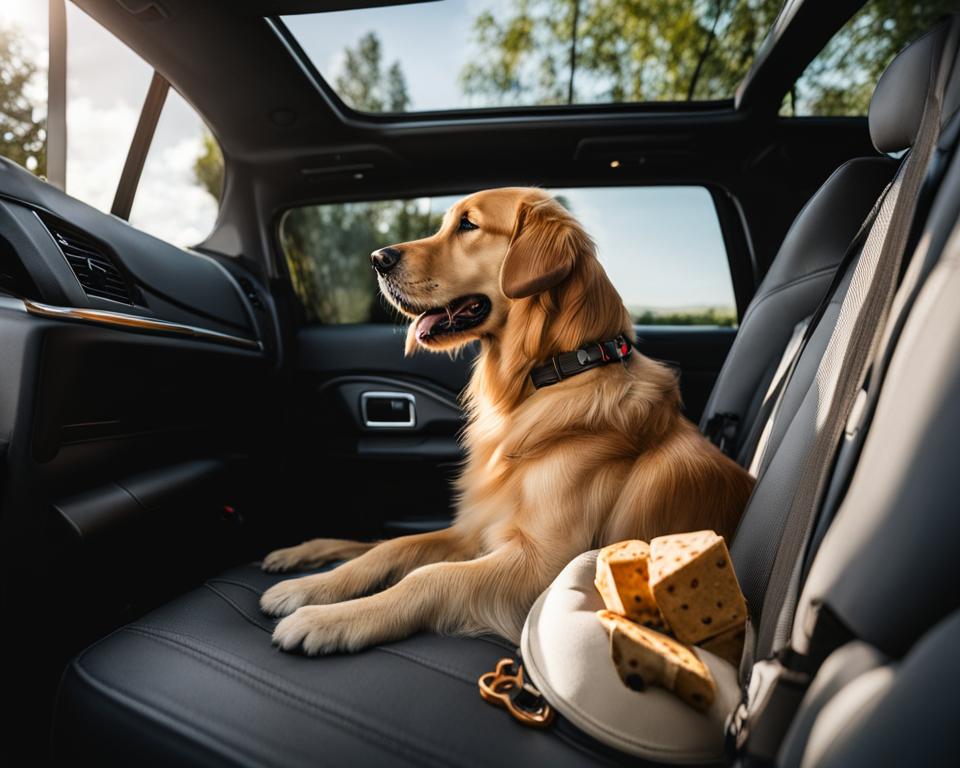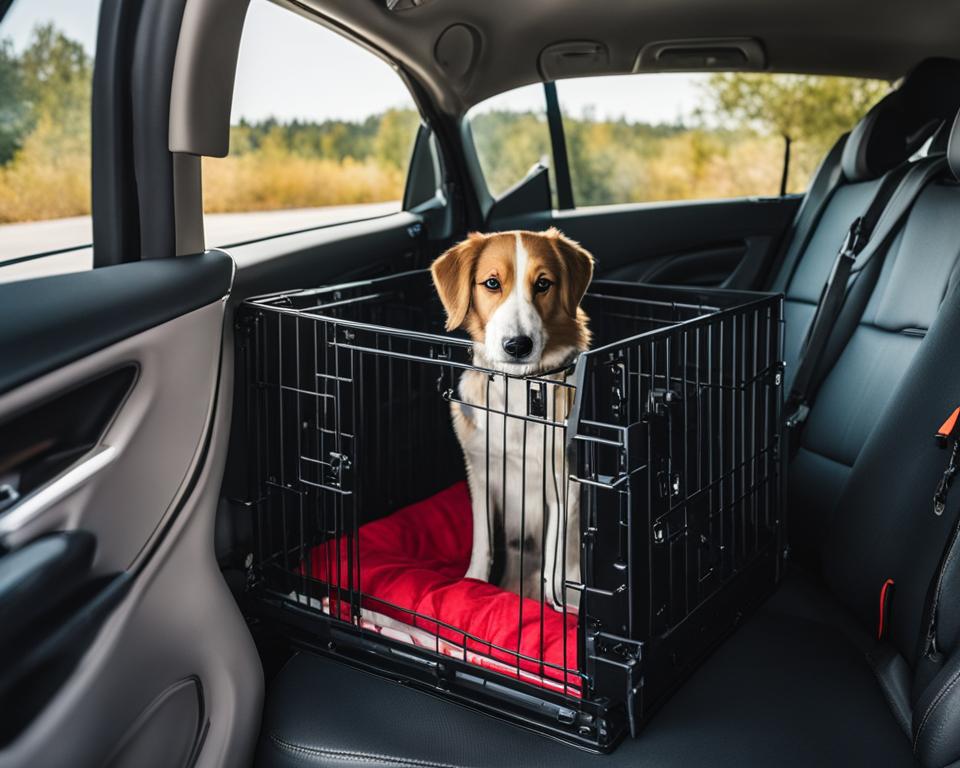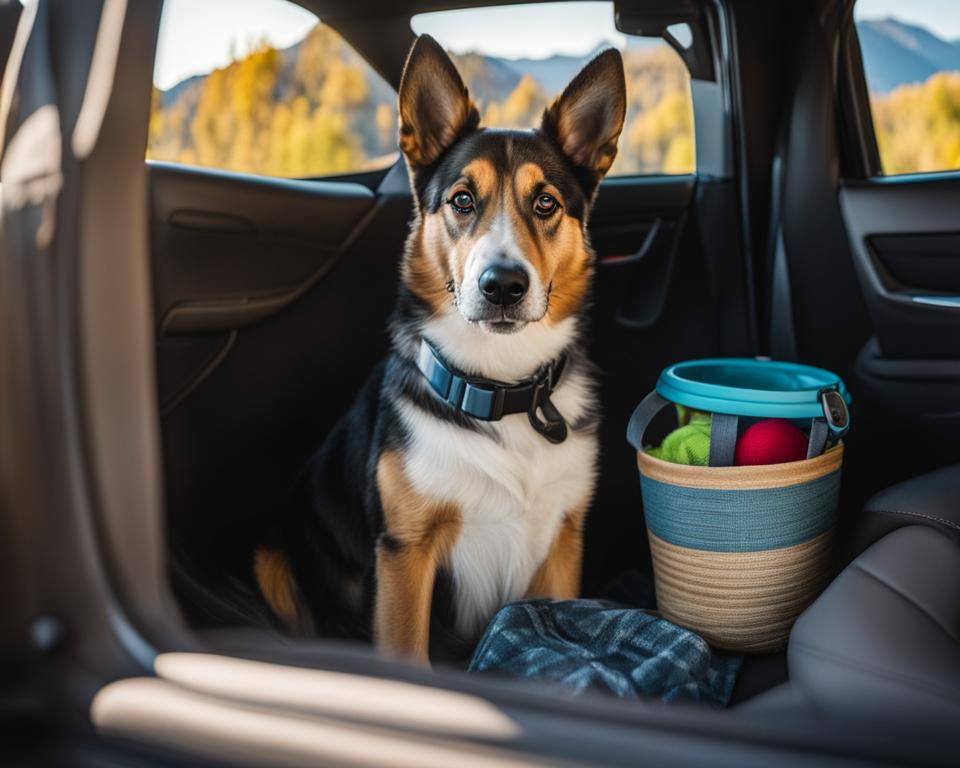Embarking on a long-distance journey with your furry friend in tow? Ensuring your beloved pet’s comfort and safety doesn’t have to be a daunting task. With the right preparation, you can make the experience enjoyable for both of you. From securing them with dog travel essentials to packing a pet-friendly first aid kit, your approach to preparing your dog for long-distance travel can help alleviate the stress commonly associated with hitting the highway. Before you start the engine, delve into the nuances of pet travel safety and arm yourself with knowledge for a smoothing sailing—and driving—adventure with your canine companion.
Key Takeaways
- Secure your dog with a crash-tested seatbelt or a comfortable travel crate to ensure their safety on the road.
- Gather essential items for a pet first aid kit, including medical records and emergency contact information, available from resources like the ASPCA.
- Consult your vet about your dog’s susceptibilities to motion sickness and the possibility of using anti-nausea medication or sedatives.
- Plan ahead for dog-friendly restaurants and stops for regular walks, as well as checking on breed-specific legislation along your route.
- Be prepared for the inevitability of messes by having cleaning supplies at the ready.
- Ensure all your accommodations are truly pet-friendly and are aware of your dog’s presence.
- Keep your dog’s microchip information up-to-date, and adhere to local leash laws for peace of mind.
Assessing Your Dog’s Travel Readiness
Getting ready for a journey requires more than just mapping out the route, especially when you’re preparing for long trips with your dog. A critical step is ensuring your canine road warrior is as prepared for the adventure as you are. Consider these thoughtful dog travel tips to evaluate whether your four-legged friend is ready to hit the road and what you can do to make the experience as seamless as possible.
Starting with Shorter Trips
Acquainting your dog with the car environment is essential for pet travel safety. Commence with brief jaunts around the neighborhood, gradually lengthening the duration. These mini-excursions serve as a warm-up, offering a sneaky peek into how your pet reacts to being in a vehicle for extended periods. It’s a practice run for the main event and helps your furry friend associate car rides with positive experiences, paving the way for successful long-distance travel.
Understanding Your Dog’s Stress Signals
Just like us, dogs exhibit signs when they’re feeling apprehensive. Watch for indicators like whining, excessive drooling, or a general hesitance to hop into the car. These could be clues pointing toward travel anxiety or more relatable issues like motion sickness. Equipping yourself with the knowledge of these signals will enable you to respond appropriately and create a reassuring environment when preparing your dog for long-distance travel.
What to Discuss with Your Vet Pre-Travel
Ahead of embarking on a long journey, scheduling a visit to the veterinarian is crucial. Address aspects like up-to-date vaccinations, the potential need for motion sickness medication, and even the possibility of sedatives if your dog is particularly anxious. A microchip implant can add an extra layer of security for your peace of mind. Your vet can provide tailored advice and dog travel tips to ensure your pet’s safety and comfort on the open road.
Remember, every dog is unique, and the aim is to anticipate their needs, ensuring they’re as ready for the upcoming trip as they possibly can be. With these steps, you’re well on your way to preparing your dog for long-distance travel in a responsible and loving manner. Safe travels!
Creating a Dog-Friendly Car Environment
When you’re planning to travel with pets, transforming your vehicle into a dog-friendly zone is a crucial step. Your primary goal is to ensure their safety and comfort during the journey. The first step in this process involves choosing the right travel crate or carrier. It should be spacious enough to allow your dog to stand, turn, and lie down without difficulty but securely fastened to prevent any movement during transit. Here are key elements to consider when creating a safe and cozy space for your dog during car travels:
- Secure Restraints: A secured carrier or well-fitted dog seatbelt is one of the top dog travel essentials to prevent them from being a distraction while you drive and protect them in case of sudden stops.
- Comfortable Bedding: Invest in a comfy pet bed or familiar blankets for insulation and a sense of security, significantly reducing travel-related stress for your canine companion.
- Non-Slip Surface: Ensure the floor area is non-slip to help your pet maintain balance and stability, which is especially important for older dogs or those with joint problems.
- Travel Barriers: Consider installing a pet barrier if you have an open car or an SUV to prevent your dog from jumping into the front seat, promoting pet travel safety.
- Level Surface: Aim to create a level resting area for your pet, especially if the car’s back seats are sloped, which might be uncomfortable during long drives.
- Temperature Control: Ensure proper ventilation and temperature control in the area where your pet is stationed to avoid overheating or getting too cold.

In addition, it’s important to condition your dog to the car environment to minimize anxiety during travel. Training your dog to stay seated or lie down using commands can contribute significantly to creating a dog-friendly travel experience and ensuring their safety. Remember to never let your dog ride with their head out the window as it poses a risk for injury. With these measures, you can ensure that traveling with your dog is a pleasant and safe experience for everyone involved.
| Dog Travel Essential | Purpose | Considerations |
|---|---|---|
| Travel Crate or Carrier | Safety during transit | Size, ventilation, ease of cleaning, and compatibility with your vehicle |
| Comfortable Bedding | Stress reduction and warmth | Washability, durability, and comfort level |
| Non-Slip Surface | Stability and safety | Material that is easy to clean and maintain |
| Pet Barrier | Prevent pets from accessing the front area | Adjustable, sturdy, and fits your car model |
| Level Surface | Comfort during rest | Use of level platforms or adjustable car seats |
| Climate Control | Temperature regulation | Car shades, fans, or additional AC units for the back |
Combining the practicality of these travel essentials with a sprinkle of love and patience will result in a dog-friendly car environment that is both relaxing and enjoyable for your pooch on long-distance adventures.
Packing Essentials for Your Dog’s Comfort and Safety
When embarking on a journey with your furry friend, whether it’s a weekend getaway or a move across the country, having the right dog travel checklist is crucial. Not only does it ensure pet travel safety, but it also makes traveling with dogs easier and less stressful for both you and your pet. Here’s what to pack to create a comfortable, safe, and enjoyable travel experience for your canine companion.
The Ultimate Dog Travel Checklist
An essential step in the preparation process is compiling a detailed packing list that caters to all your dog’s needs during the trip. Here’s an important list of items to consider:
- ID tag with your current contact information
- Leash and collar with a secure clasp
- Portable water and food bowls
- Supply of your dog’s regular food to avoid stomach upsets
- Any prescribed medications with dosage instructions
- Comfort items like favorite toys
- Waste disposal items, including waste bags

First Aid Kit Contents for Canine Emergencies
Being proactive often means preparing for the unexpected. Packing a dedicated dog first aid kit is a smart move to address any health emergencies while on the road. Include the following items:
- Medical records and up-to-date vaccination info
- Emergency contact numbers for vet and animal hospitals along the route
- Bandages and antiseptics for minor injuries
- 3% hydrogen peroxide to induce vomiting if advised by vet
- Styptic powder to stop nail bleeding
- Scissors and tweezers for when you need them most
Hydration and Nutrition on the Go
Consistency in feeding and hydration is key for traveling with dogs. Make sure to stick to your pet’s normal feeding routine and offer water at least every hour to prevent dehydration. Avoid feeding your furry companion in a moving vehicle which can help prevent car sickness. Instead, plan stops along the way to allow meal times and bathroom breaks. Maintaining a sense of normalcy in your dog’s diet will keep them comfortable and content throughout the journey.
| Item | Use |
|---|---|
| ID Tag | To easily identify your pet and your contact information |
| Leash | Mandatory for walks and ensuring your dog is always secured |
| Water/Food Bowls | For proper hydration and nutrition on the road |
| Regular Dog Food | To avoid dietary upsets by changing their food |
| Medications | For any ongoing treatment and emergency situations |
| Favorite Toys | To provide comfort and a sense of familiarity during travel |
| Waste Bags | To responsibly dispose of pet waste during stops |
Understanding and Adhering to Pet Travel Regulations
When gearing up for a trip that includes your beloved canine companion, understanding and adhering to pet travel safety regulations is just as critical as packing their favorite toy. To guarantee a trip without legal hitches, it’s vital to stay informed about the latest travel regulations affecting pets and take proactive steps in compliance.
First things first, verifying that your dog’s vaccinations are up to date is paramount. Different regions have specific health requirements, and it is your responsibility to carry proof such as a current health certificate, especially if your travels take you across state or international borders. Not only does this safeguard your pet’s health, but it also ensures that you’re abiding by the regulations of your destination.
Another key aspect of travel with pets includes understanding the breed-specific legislation that could affect your journey. It’s unfortunate but true that some areas may have restrictions or bans on specific dog breeds. Coordinating with your veterinarian is crucial here; they can help you obtain all the necessary documentation and advise you on how to navigate areas with breed-specific laws.
The inclusion of a microchip in your dog’s travel preparation can prove indispensable. Should your dog ever get lost, a microchip with up-to-date contact information significantly increases the likelihood of a happy reunion. It is also wise to update your dog’s identification tags before setting out on your travels.
Let’s not forget about the plethora of dog-friendly travel establishments dotting your route. Meticulous planning to identify these pet-friendly hotels, restaurants, parks, and other amenities will help ensure a smooth and enjoyable journey for you and your pet. Be sure to note down any specific paperwork or requirements these places may have when it comes to accommodating your furry friend.
Adhering to these regulations doesn’t need to be a daunting task. A well-planned trip where every legal and safety aspect has been considered will enable you and your dog to enjoy the wonders of travel without worry.
| Regulation/Requirement | Details | Action Items |
|---|---|---|
| Vaccination Proof | Required by many destinations for health and safety. | Carry up-to-date vaccination records, including rabies. |
| Breed-Specific Legislation | Breed bans or restrictions in certain areas. | Research and plan route to avoid such areas if they affect your breed. |
| Identification Tags | Tags with current contact information. | Update tags and consider a microchip for additional safety. |
| Pet-Friendly Establishments | Accommodations that welcome pets may have specific requirements. | Plan and confirm arrangements in advance. |

With a thoughtful approach to compliance, your journey can be transformed from a potential bureaucratic headache into a seamless adventure that prioritizes pet travel safety and enjoyment. Safe and compliant travels!
Perfecting the Pit Stop: Exercise and Feeding Schedule
When you’re preparing for long trips with your dog, planning your pit stops is an exercise in mindfulness. For your canine’s happiness and health, it’s essential to map out your journey with your pet’s routine in mind. Skillful timing and location choice for breaks will be the linchpin in a harmonious travel experience, ensuring that you maintain the familiar rhythm of your dog’s day-to-day life – even on the road.
Maintaining Your Dog’s Routine During Travel
One of the key dog travel tips for reducing travel anxiety is adhering to your dog’s normal routine as closely as possible. Your dog thrives on consistency, and the relative unpredictability of travel can be mitigated by maintaining regular feeding, walking, and rest times. Experts recommend stopping every 2-3 hours for bathroom breaks and stretching, which aligns nicely with most dogs’ natural schedules. These consistent breaks for exercise and relief are not just a courtesy but a necessity to keep your dog relaxed and comfortable.
Sourcing Dog-Friendly Stopovers
Amidst a landscape where “no pets allowed” signs are all too common, sourcing dog-friendly travel stopovers requires a proactive approach. Identifying green spaces, dog parks, or dog-friendly dining options provides a safe haven for meals and play, keeping you and your furry friend content. Thankfully, a wave of establishments that cater to canine companions is on the rise, making these pet-attuned choices increasingly viable. A smart traveler plans ahead, pinning down these pet-welcoming locales to ensure that every stopover enhances your journey, transforming a simple break into cherished moments with your dog.
By integrating these considerations into your planning, traveling with dogs becomes less about the stress of the journey and more about the joy of shared exploration. Keep the spirit of adventure alive and your dog’s tail wagging by perfecting the art of the pit stop.
FAQ
How can I prepare my dog for long-distance travel?
Start by ensuring your dog is comfortable with car rides by taking them on shorter trips. Pack all the essentials such as their crate, favorite toys, food, water, and bowls. Use a crash-tested seat belt or crate for their safety and keep a travel-friendly first aid kit. Lastly, make frequent stops for exercise and to maintain their regular feeding schedule.
What steps can I take to assess my dog’s travel readiness?
Begin with brief car rides to acclimatize your dog to vehicle movements. Observe for stress signals like excessive panting or whining, and consult with your veterinarian for a pre-travel check-up to discuss any travel concerns and to update vaccinations. A microchip is also advisable for safety.
How do I create a dog-friendly car environment?
Secure your dog’s crate or carrier in the vehicle, ensure it’s spacious, and make the surface level and comfortable with blankets or a pet bed. Consider adding seat covers or barriers if you travel frequently, and train your dog to stay seated or lay down quietly in their space.
What should I pack for my dog’s safety and comfort during travel?
Your dog’s travel checklist should include an ID tag, leash, food, water, bowls, medications, toys, and waste disposal bags. A canine first aid kit with bandages, antiseptics, and emergency contact info is vital. Keep your pet hydrated, offer meals at their usual times, and avoid feeding while in motion.
What do I need to know about pet travel regulations?
Research and comply with the latest pet travel regulations, including proof of vaccination, understanding breed-specific legislation, and securing a health certificate if required. Ensure your dog’s identification tags are updated, and consider microchipping for added security.
How can I keep my dog’s routine consistent during long-distance travel?
Plan for regular breaks every few hours to allow your dog to use the bathroom and get some exercise. Try to maintain their normal feeding and walking schedule as much as possible, and seek out dog-friendly locations for stops to help your dog stay relaxed and engaged.
Where can I find dog-friendly stopovers for traveling with my dog?
Research online for pet-friendly rest stops, hotels, and restaurants. Websites and apps catering to pet travel can provide listings and reviews for suitable locations. Look for places with open spaces for your dog to stretch and relieve themselves comfortably.

